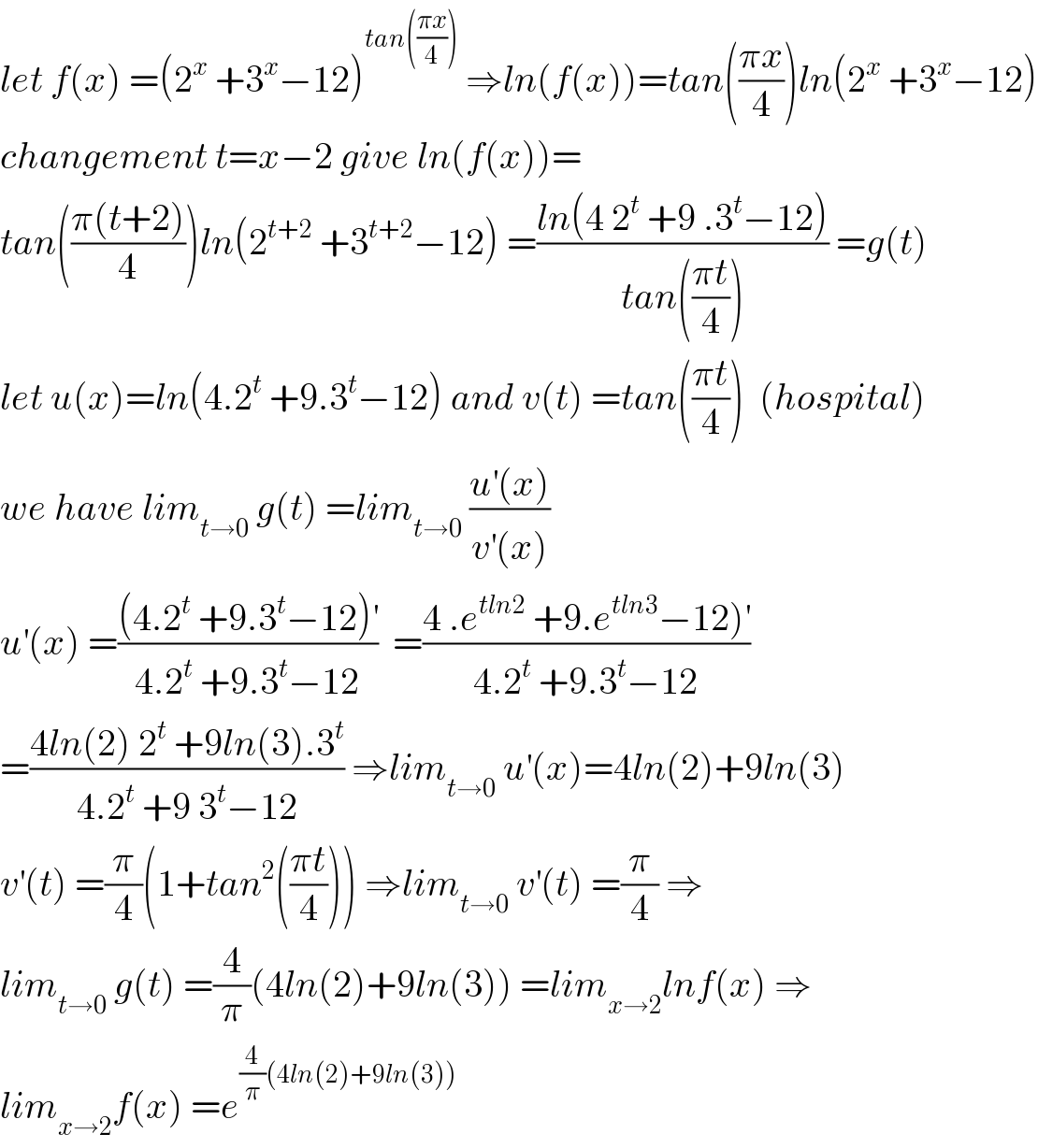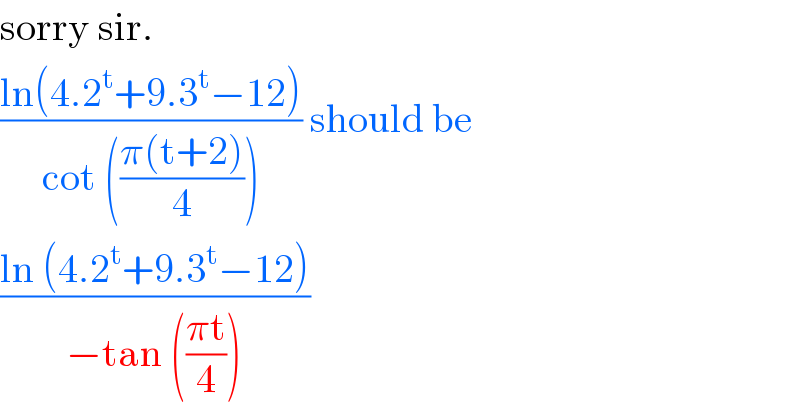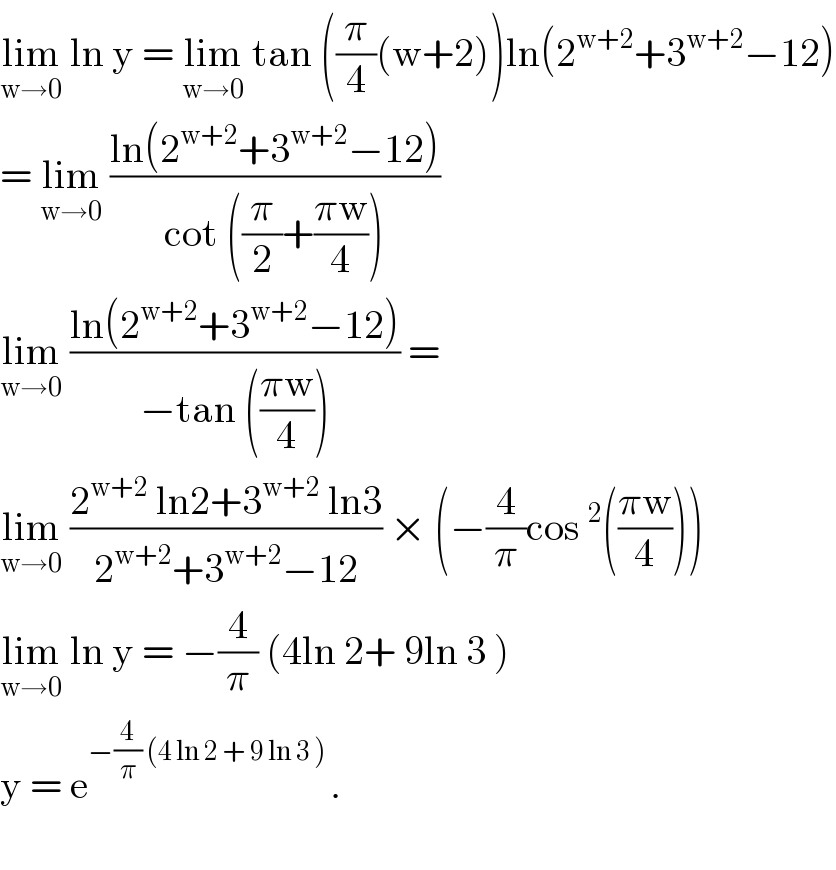
Question Number 93200 by i jagooll last updated on 11/May/20

Commented by mathmax by abdo last updated on 11/May/20

$${let}\:{f}\left({x}\right)\:=\left(\mathrm{2}^{{x}} \:+\mathrm{3}^{{x}} −\mathrm{12}\right)^{{tan}\left(\frac{\pi{x}}{\mathrm{4}}\right)} \:\Rightarrow{ln}\left({f}\left({x}\right)\right)={tan}\left(\frac{\pi{x}}{\mathrm{4}}\right){ln}\left(\mathrm{2}^{{x}} \:+\mathrm{3}^{{x}} −\mathrm{12}\right) \\ $$$${changement}\:{t}={x}−\mathrm{2}\:{give}\:{ln}\left({f}\left({x}\right)\right)= \\ $$$${tan}\left(\frac{\pi\left({t}+\mathrm{2}\right)}{\mathrm{4}}\right){ln}\left(\mathrm{2}^{{t}+\mathrm{2}} \:+\mathrm{3}^{{t}+\mathrm{2}} −\mathrm{12}\right)\:=\frac{{ln}\left(\mathrm{4}\:\mathrm{2}^{{t}} \:+\mathrm{9}\:.\mathrm{3}^{{t}} −\mathrm{12}\right)}{{tan}\left(\frac{\pi{t}}{\mathrm{4}}\right)}\:={g}\left({t}\right) \\ $$$${let}\:{u}\left({x}\right)={ln}\left(\mathrm{4}.\mathrm{2}^{{t}} \:+\mathrm{9}.\mathrm{3}^{{t}} −\mathrm{12}\right)\:{and}\:{v}\left({t}\right)\:={tan}\left(\frac{\pi{t}}{\mathrm{4}}\right)\:\:\left({hospital}\right) \\ $$$${we}\:{have}\:{lim}_{{t}\rightarrow\mathrm{0}} \:{g}\left({t}\right)\:={lim}_{{t}\rightarrow\mathrm{0}} \:\frac{{u}^{'} \left({x}\right)}{{v}^{'} \left({x}\right)} \\ $$$${u}^{'} \left({x}\right)\:=\frac{\left(\mathrm{4}.\mathrm{2}^{{t}} \:+\mathrm{9}.\mathrm{3}^{{t}} −\mathrm{12}\right)^{'} }{\mathrm{4}.\mathrm{2}^{{t}} \:+\mathrm{9}.\mathrm{3}^{{t}} −\mathrm{12}}\:\:=\frac{\left.\mathrm{4}\:.{e}^{{tln}\mathrm{2}} \:+\mathrm{9}.{e}^{{tln}\mathrm{3}} −\mathrm{12}\right)^{'} }{\mathrm{4}.\mathrm{2}^{{t}} \:+\mathrm{9}.\mathrm{3}^{{t}} −\mathrm{12}} \\ $$$$=\frac{\mathrm{4}{ln}\left(\mathrm{2}\right)\:\mathrm{2}^{{t}} \:+\mathrm{9}{ln}\left(\mathrm{3}\right).\mathrm{3}^{{t}} }{\mathrm{4}.\mathrm{2}^{{t}} \:+\mathrm{9}\:\mathrm{3}^{{t}} −\mathrm{12}}\:\Rightarrow{lim}_{{t}\rightarrow\mathrm{0}} \:{u}^{'} \left({x}\right)=\mathrm{4}{ln}\left(\mathrm{2}\right)+\mathrm{9}{ln}\left(\mathrm{3}\right) \\ $$$${v}^{'} \left({t}\right)\:=\frac{\pi}{\mathrm{4}}\left(\mathrm{1}+{tan}^{\mathrm{2}} \left(\frac{\pi{t}}{\mathrm{4}}\right)\right)\:\Rightarrow{lim}_{{t}\rightarrow\mathrm{0}} \:{v}^{'} \left({t}\right)\:=\frac{\pi}{\mathrm{4}}\:\Rightarrow \\ $$$${lim}_{{t}\rightarrow\mathrm{0}} \:{g}\left({t}\right)\:=\frac{\mathrm{4}}{\pi}\left(\mathrm{4}{ln}\left(\mathrm{2}\right)+\mathrm{9}{ln}\left(\mathrm{3}\right)\right)\:={lim}_{{x}\rightarrow\mathrm{2}} {lnf}\left({x}\right)\:\Rightarrow \\ $$$${lim}_{{x}\rightarrow\mathrm{2}} {f}\left({x}\right)\:={e}^{\frac{\mathrm{4}}{\pi}\left(\mathrm{4}{ln}\left(\mathrm{2}\right)+\mathrm{9}{ln}\left(\mathrm{3}\right)\right)} \\ $$
Commented by john santu last updated on 12/May/20

$$\mathrm{sorry}\:\mathrm{sir}.\: \\ $$$$\frac{\mathrm{ln}\left(\mathrm{4}.\mathrm{2}^{\mathrm{t}} +\mathrm{9}.\mathrm{3}^{\mathrm{t}} −\mathrm{12}\right)}{\mathrm{cot}\:\left(\frac{\pi\left(\mathrm{t}+\mathrm{2}\right)}{\mathrm{4}}\right)}\:\mathrm{should}\:\mathrm{be}\: \\ $$$$\frac{\mathrm{ln}\:\left(\mathrm{4}.\mathrm{2}^{\mathrm{t}} +\mathrm{9}.\mathrm{3}^{\mathrm{t}} −\mathrm{12}\right)}{−\mathrm{tan}\:\left(\frac{\pi\mathrm{t}}{\mathrm{4}}\right)}\: \\ $$
Commented by mathmax by abdo last updated on 12/May/20

$${yes}\:{forget}\:{the}\:{sign}\:− \\ $$
Answered by john santu last updated on 12/May/20

$$\underset{\mathrm{w}\rightarrow\mathrm{0}} {\mathrm{lim}}\:\mathrm{ln}\:\mathrm{y}\:=\:\underset{\mathrm{w}\rightarrow\mathrm{0}} {\mathrm{lim}}\:\mathrm{tan}\:\left(\frac{\pi}{\mathrm{4}}\left(\mathrm{w}+\mathrm{2}\right)\right)\mathrm{ln}\left(\mathrm{2}^{\mathrm{w}+\mathrm{2}} +\mathrm{3}^{\mathrm{w}+\mathrm{2}} −\mathrm{12}\right) \\ $$$$=\:\underset{\mathrm{w}\rightarrow\mathrm{0}} {\mathrm{lim}}\:\frac{\mathrm{ln}\left(\mathrm{2}^{\mathrm{w}+\mathrm{2}} +\mathrm{3}^{\mathrm{w}+\mathrm{2}} −\mathrm{12}\right)}{\mathrm{cot}\:\left(\frac{\pi}{\mathrm{2}}+\frac{\pi\mathrm{w}}{\mathrm{4}}\right)} \\ $$$$\underset{\mathrm{w}\rightarrow\mathrm{0}} {\mathrm{lim}}\:\frac{\mathrm{ln}\left(\mathrm{2}^{\mathrm{w}+\mathrm{2}} +\mathrm{3}^{\mathrm{w}+\mathrm{2}} −\mathrm{12}\right)}{−\mathrm{tan}\:\left(\frac{\pi\mathrm{w}}{\mathrm{4}}\right)}\:= \\ $$$$\underset{\mathrm{w}\rightarrow\mathrm{0}} {\mathrm{lim}}\:\frac{\mathrm{2}^{\mathrm{w}+\mathrm{2}} \:\mathrm{ln2}+\mathrm{3}^{\mathrm{w}+\mathrm{2}} \:\mathrm{ln3}}{\mathrm{2}^{\mathrm{w}+\mathrm{2}} +\mathrm{3}^{\mathrm{w}+\mathrm{2}} −\mathrm{12}}\:×\:\left(−\frac{\mathrm{4}}{\pi}\mathrm{cos}\:^{\mathrm{2}} \left(\frac{\pi\mathrm{w}}{\mathrm{4}}\right)\right) \\ $$$$\underset{\mathrm{w}\rightarrow\mathrm{0}} {\mathrm{lim}}\:\mathrm{ln}\:\mathrm{y}\:=\:−\frac{\mathrm{4}}{\pi}\:\left(\mathrm{4ln}\:\mathrm{2}+\:\mathrm{9ln}\:\mathrm{3}\:\right)\: \\ $$$$\mathrm{y}\:=\:\mathrm{e}^{−\frac{\mathrm{4}}{\pi}\:\left(\mathrm{4}\:\mathrm{ln}\:\mathrm{2}\:+\:\mathrm{9}\:\mathrm{ln}\:\mathrm{3}\:\right)\:} .\: \\ $$$$ \\ $$
Commented by i jagooll last updated on 12/May/20

$$\mathrm{yeahh}... \\ $$
